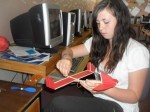Hello Friends!
Darcy Whyte
Hello Friends!

Here’s an interesting education program using Squirrels. Squirrel is simple enough that it was just one of three different projects within the program. They started with some experiments and a paper plane, moved onto a walkalong glider and then finally a Squirrel.
Check this out. It’s a cool walkalong glider!
Summer 2009 I visited Slater Harrison who’s a school teacher in Pennsylvania who has been building Squirrel model air planes as part of his science classes. We met on-line when Slater discovered the Squirrel design and started to build them with his students. The Squirrel is an excellent project for the classroom. Check out the education section of this Web site.
After a warm meal and a beer at his amazing home in the country, we got right down to talking about aircraft design and how to make things work better in the classroom. I built a Squirrel to show wood sizes and the techniques I was using.
I hadn’t really done much with walkalong gliders but Slater was very eager to show off his walkalong design that he had been working on. After he had flown it around is living room and kitchen area, I was hooked.
The next morning I had the privileged of visiting his classroom so he could show me the ropes of the walkalong glider. His classroom is great. All the chairs and such are in a square in the middle so that you can do a circuit around the classroom.
Slater showed me the techniques of flying the walkalongs that he had learned. We also built several gliders and ran them around the classroom. We experimented with a few of the design elements.
Here he is demonstrating the design. I think a walkalong is a great idea because of its simplicity. No elastic bands, propellers or anything like that. Further, it’s made from the pages of a phone book using clear tape and a piece of a straw. This makes for a fairly low cost project.
There is still a fairly steep learning curve for flying it.
An experimental modification that resulted in a slightly faster flying glider.
It wound up being fairly fast and even more challenging to fly. So it’s pretty clear that the trick is to get the flying speed down.
But you can sure get a sense of how fun it is from the video we took of it.
I theorized that a longer coupled design would be easier to trip so we could optimise the glide better. So I created one with a horizontal stabilizer (canard) in the front. I was able to get a good glide but it proved to be very difficult to fly. In retrospect this is because the lift is being applied to the wing and not to the canard area (because it’s too far away). So another thing I learned was that a walkalong needs to be a short coupled design.
After a few tries, Slater got the long coupled design working. He held the cardboard at a more shallow angle.
I’m supposing that this increased the size of the wave that is lifting the airplane so that it includes the wing and canard.
I’m tempted to say that it’s just a matter of learning the new design but I still think that the long coupled design doesn’t work because it requires the cardboard for pushing the air. The stock design that Slater already had going could be flown with just his hands which is pretty cool.
We played around with a few variations of the longer design as well as some other ideas.
We also looked at some tumblewing designs that he had on hand.
Tumblewing designs are incredibly easy to make out of tissue paper. They are easy to trim and fly well. Also fairly easy to fly.
I had a tumblewing on my drawing board and after seeing that I realize it’s already been done. And well done so I decided to drop that from my design lab.
After we tinkered with the design for a while we did some experiments in the gym. I was able to get better flights in the gym but I still hadn’t mastered how to fly the walkalong gliders.
Slater and I did some dolly shots of some of the gliders so that he could include them in some of his videos. I did some of the shots with his scooter and some by foot. We did some stationary camera shots to try to calculate the glide angles as well. I’m curious to see what becomes of those videos.
I had the pleasure of staying at Slater’s place in the country in Pennsylvania. Very nice place. Here are a few random pictures from around his yard.